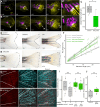This is a preprint.
Adult caudal fin shape is imprinted in the embryonic fin fold
- PMID: 39071346
- PMCID: PMC11275767
- DOI: 10.1101/2024.07.16.603744
Adult caudal fin shape is imprinted in the embryonic fin fold
Abstract
Appendage shape is formed during development (and re-formed during regeneration) according to spatial and temporal cues that orchestrate local cellular morphogenesis. The caudal fin is the primary appendage used for propulsion in most fish species, and exhibits a range of distinct morphologies adapted for different swimming strategies, however the molecular mechanisms responsible for generating these diverse shapes remain mostly unknown. In zebrafish, caudal fins display a forked shape, with longer supportive bony rays at the periphery and shortest rays at the center. Here, we show that a premature, transient pulse of sonic hedgehog a (shha) overexpression during late embryonic development results in excess proliferation and growth of the central rays, causing the adult caudal fin to grow into a triangular, truncate shape. Both global and regional ectopic shha overexpression are sufficient to alter fin shape, and forked shape may be rescued by subsequent treatment with an antagonist of the canonical Shh pathway. The induced truncate fins show a decreased fin ray number and fail to form the hypural diastema that normally separates the dorsal and ventral fin lobes. While forked fins regenerate their original forked morphology, truncate fins regenerate truncate, suggesting that positional memory of the fin rays can be permanently altered by a transient treatment during embryogenesis. Ray finned fish have evolved a wide spectrum of caudal fin morphologies, ranging from truncate to forked, and the current work offers insights into the developmental mechanisms that may underlie this shape diversity.
Keywords: Caudal fin; positional information; proliferation; shape; sonic hedgehog.
Figures




Similar articles
-
Basal epidermis collective migration and local Sonic hedgehog signaling promote skeletal branching morphogenesis in zebrafish fins.Dev Biol. 2021 Sep;477:177-190. doi: 10.1016/j.ydbio.2021.04.010. Epub 2021 May 24. Dev Biol. 2021. PMID: 34038742 Free PMC article.
-
Robust and local positional information within a fin ray directs fin length during zebrafish regeneration.Dev Growth Differ. 2018 Aug;60(6):354-364. doi: 10.1111/dgd.12558. Epub 2018 Jul 10. Dev Growth Differ. 2018. PMID: 29992536
-
Involvement of the sonic hedgehog, patched 1 and bmp2 genes in patterning of the zebrafish dermal fin rays.Development. 1998 Nov;125(21):4175-84. doi: 10.1242/dev.125.21.4175. Development. 1998. PMID: 9753672
-
The Water to Land Transition Submerged: Multifunctional Design of Pectoral Fins for Use in Swimming and in Association with Underwater Substrate.Integr Comp Biol. 2022 Oct 29;62(4):908-921. doi: 10.1093/icb/icac061. Integr Comp Biol. 2022. PMID: 35652788 Free PMC article. Review.
-
Developmental change in the function of movement systems: transition of the pectoral fins between respiratory and locomotor roles in zebrafish.Integr Comp Biol. 2014 Jul;54(2):238-49. doi: 10.1093/icb/icu014. Epub 2014 Apr 17. Integr Comp Biol. 2014. PMID: 24748600 Free PMC article. Review.
References
-
- Sears K, Maier JA, Sadier A, Sorensen D, Urban DJ. Timing the developmental origins of mammalian limb diversity. genesis. 2018;56(1):e23079. - PubMed
-
- Wolpert L. Positional information and pattern formation in development. Dev Genet. 1994;15(6):485–90. - PubMed
-
- Polly PD. Chapter 15. Limbs in Mammalian Evolution. In: Chapter 15 Limbs in Mammalian Evolution. University of Chicago Press; 2008. p. 245–68.
-
- Webb PW. Body Form, Locomotion and Foraging in Aquatic Vertebrates. Am Zool. 1984. Feb;24(1):107–20.
-
- Tack NB, Gemmell BJ. A tale of two fish tails: does a forked tail really perform better than a truncate tail when cruising? J Exp Biol. 2022. Nov 24;225(22):jeb244967. - PubMed
Publication types
Grants and funding
LinkOut - more resources
Full Text Sources
